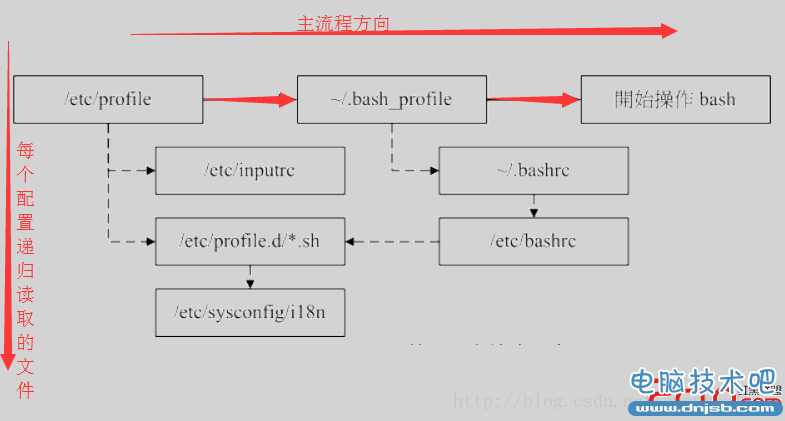Linuxlogin&non-loginshell以及su,sudo相关概念
发布时间:2015-02-02 18:34:34作者:知识屋
1.login & non-login shell
Linux系统自举时,内核会创建init进程,来进行一系列的系统初始化操作。每一个用户登录shell时,无论以伪终端登录:ssh,X11下控制台,还是tty控制台终端,都会读取相关相关的登录配置文件。linux 有两种登录shell:login和nologin:
login shell:登录shell时需要完整的登录流程,称为 login shell。何为完整:输入用户名和密码。例如:走tty1-tty6控制终端,或走ssh等伪终端远程登入non-login shell:登入shell时不需要输入帐号信息。例如在X11下,打开伪终端,或者在shell下,进入shell子进程。这两种登入shell的区别是:在登入shell是,读取的配置文件不同。这里先介绍两个配置文件/etc/profile和~/.bashrc,在unix系统中,这两个shell环境的配置文件,是我们接触最多的两个文件:
/etc/profile,处在shell配置文件的最顶端。这是系统shell环境的全局设定,例如PATH,MAIL很多环境变量。对它的修改,会影响到所有用户。~/.bashrc,处在shell配置文件的最低端。这是针对每个用户shell环境的配置文件,我们的大部分个性化的定制,都可以直接修改在这个文件中。login shell(bash)在登入时,会读取的配置文件:
/etc/profile,全局配置~/.bash_profile 或~/.bash_login 或 ~/.profile,个人配置。之所以有三个文件,是因为不同的shell有可能命名不同,只会按顺序读取其中的一个。其实登入时不仅仅读取这两个文件,其中在/etc/profile文件中,还会摄入其他的配置文件,例如我的ubuntu机器上该文件的内容如下:
# /etc/profile: system-wide .profile file for the Bourne shell (sh(1))# and Bourne compatible shells (bash(1), ksh(1), ash(1), ...).if [ "$PS1" ]; then #如果shell环境存在且不为sh,就读取/etc/bash.bashrc if [ "$BASH" ] && [ "$BASH" != "/bin/sh" ]; then # The file bash.bashrc already sets the default PS1. # PS1='/h:/w/$ ' if [ -f /etc/bash.bashrc ]; then . /etc/bash.bashrc fi else if [ "`id -u`" -eq 0 ]; then PS1='# ' else PS1='$ ' fi fifi# The default umask is now handled by pam_umask.# See pam_umask(8) and /etc/login.defs.#读取/etc/profile.d目录下所有的sh文件if [ -d /etc/profile.d ]; then for i in /etc/profile.d/*.sh; do if [ -r $i ]; then . $i fi done unset ifi对于我的ubuntu机器中~/.profile文件内容如下:最后shell会读取~/.bashrc文件。
# ~/.profile: executed by the command interpreter for login shells.# This file is not read by bash(1), if ~/.bash_profile or ~/.bash_login# exists.# see /usr/share/doc/bash/examples/startup-files for examples.# the files are located in the bash-doc package.# the default umask is set in /etc/profile; for setting the umask# for ssh logins, install and configure the libpam-umask package.#umask 022# if running bashif [ -n "$BASH_VERSION" ]; then # include .bashrc if it exists if [ -f "$HOME/.bashrc" ]; then . "$HOME/.bashrc" fifi# set PATH so it includes user's private bin if it existsif [ -d "$HOME/bin" ] ; then PATH="$HOME/bin:$PATH"fi
login shell读取配置的流程如下图(来自:<鸟哥>):

non-login shell(bash)在登入时,只会读取的配置文件:~/.bashrc。bashrc这个文件有时候不存在,需要自己创建,里面可以进行个性化的定制,不会影响到其他用户。
2.su &sudo
在我接触的Linux 发行版中,ubuntu在安装过程中不会提示root密码的设置,只有进入系统后才能在shell下通过passwd来设置root的密码,fedora,centos安装过程中多会要求设置root密码和建立一个常用的用户。可以看出linux的设计者们本身就期望用户以较低的权限来进行平时的操作,这是基于于安全的考虑。
但在shell环境下,由于各种工作的需要,我们经常需要进行用户权限的切换,最常用的就是获取root用户的权限。最常用的命令有su和sudo。
su [-lc] [username]- , -l, --login : 表示使用以login shell的方式登录username,若username为空,则默认登录root。 如果没有该参数,则以nonlogin的方式登录-c, 仅执行一次命令 ,命令需要用引号括起来这里要强调的就是su 和su -的区别,就是前面撤了一大串的login 和non-login的区别。
sudo命令的存在我觉得有两个原因:
使用su切换到root,需要是所有用户都知道root密码,不安全;很多时候我们切换到root用户只是需要执行一条语句,尽管su -c可以完成,但每次都要敲个空格-c,而且每次都要输入root密码;上面两个原因,就是sudo存在的理由。sudo可以让用户通过验证自己的密码来获得其他用户的权限,只需要root对/etc/sudoers进行相关的配置,我的sudoers文件的内容如下:
# User privilege specificationroot ALL=(ALL:ALL) ALL# admin组成员可以切换到任何用户执行任何命令%admin ALL=(ALL) ALL# Allow members of group sudo to execute any command%sudo ALL=(ALL:ALL) ALL#users群组不需要密码进行切换%users ALL=(ALL) NOPASSWD:ALL#允许guest切换到samba_group组中的所有用户guest ALL=(%samba_group:ALL) ALLsudoers中设置一个用户具有sudo权限的方式如下:
登入者账号 登入者的来源主机名=(可切换身份)可执行的命令
登入者帐号可以为:个人,群组,别名。群组需要在前面加%来标志
对于别名,sudoers结构的四个组成部分都可以用别名表示:User_Alias , Runas_Alias, Host_Alias, Cmnd_Alias
每个别名的命名格式:Alias_Type NAME = item1, item2, ...,别名NAME必须由大写字母,数字,下划线组成,开头为大写字母。
例如:
User_Alias SBGROUP = user1, user2, user3
SBGROUP ALL=(ALL) ALL
为了保证/etc/sudoers语法的正确,我们一般通过visudo来编辑该文件。
相关知识
-

linux一键安装web环境全攻略 在linux系统中怎么一键安装web环境方法
-

Linux网络基本网络配置方法介绍 如何配置Linux系统的网络方法
-
Linux下DNS服务器搭建详解 Linux下搭建DNS服务器和配置文件
-
对Linux进行详细的性能监控的方法 Linux 系统性能监控命令详解
-
linux系统root密码忘了怎么办 linux忘记root密码后找回密码的方法
-
Linux基本命令有哪些 Linux系统常用操作命令有哪些
-
Linux必学的网络操作命令 linux网络操作相关命令汇总
-

linux系统从入侵到提权的详细过程 linux入侵提权服务器方法技巧
-

linux系统怎么用命令切换用户登录 Linux切换用户的命令是什么
-
在linux中添加普通新用户登录 如何在Linux中添加一个新的用户
软件推荐
更多 >-
1
 专为国人订制!Linux Deepin新版发布
专为国人订制!Linux Deepin新版发布2012-07-10
-
2
CentOS 6.3安装(详细图解教程)
-
3
Linux怎么查看网卡驱动?Linux下查看网卡的驱动程序
-
4
centos修改主机名命令
-
5
Ubuntu或UbuntuKyKin14.04Unity桌面风格与Gnome桌面风格的切换
-
6
FEDORA 17中设置TIGERVNC远程访问
-
7
StartOS 5.0相关介绍,新型的Linux系统!
-
8
解决vSphere Client登录linux版vCenter失败
-
9
LINUX最新提权 Exploits Linux Kernel <= 2.6.37
-
10
nginx在网站中的7层转发功能
























